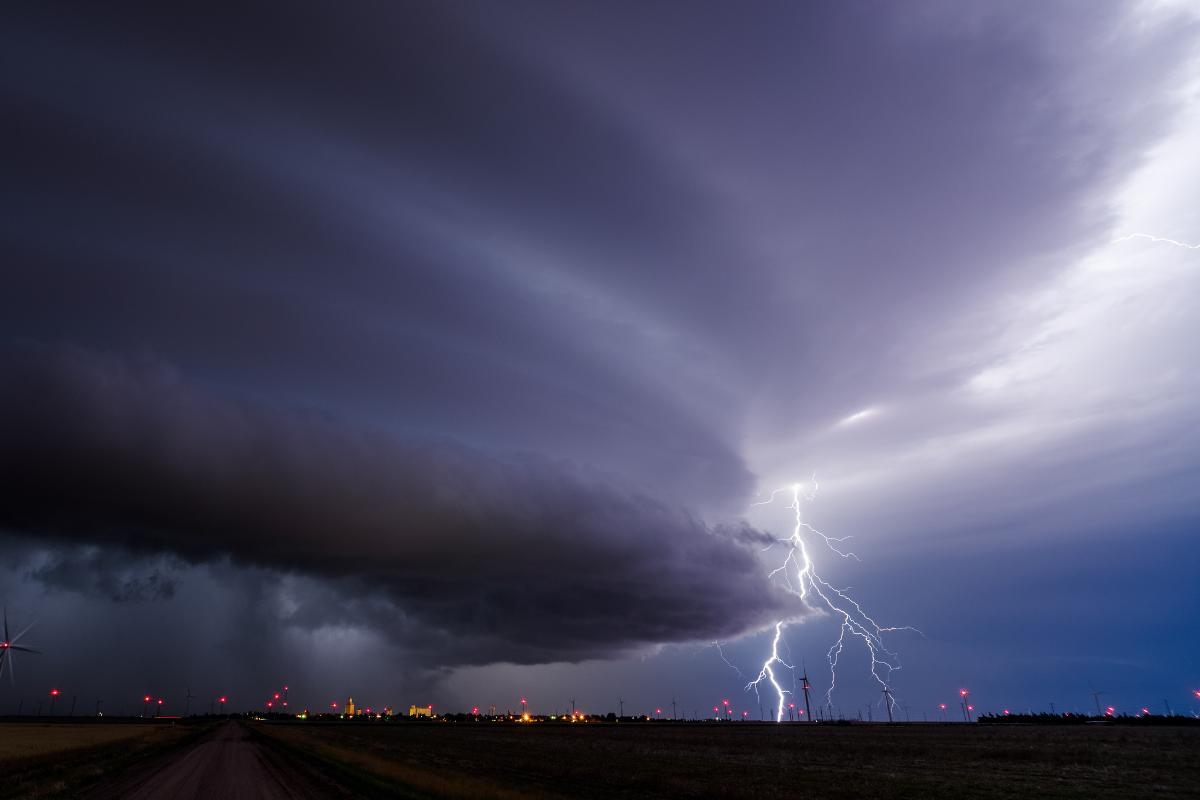What Causes Thunderstorms?


Thunderstorms are one of nature’s most powerful and dramatic weather phenomena, often marked by flashes of lightning, rumbling thunder, and heavy rain. But have you ever wondered what causes these intense storms to form? Understanding the science behind thunderstorms can help us better appreciate their complexity and the factors that contribute to their development. Additionally, with climate change influencing weather patterns globally, the frequency and intensity of thunderstorms may be shifting in certain regions.
In this guide, we'll explore how thunderstorms form, the atmospheric conditions that trigger them, and the different types of thunderstorms you might encounter.
What are thunderstorms?
Thunderstorms are meteorological phenomena that occur when the atmosphere becomes unstable, typically due to the heating of air at the Earth's surface. This warm air rises rapidly, and upon reaching cooler layers of the atmosphere, it condenses to form towering clouds known as cumulonimbus clouds.
Within these clouds, the movement of air creates a separation of electrical charges: positive charges accumulate at the top, while negative charges gather at the bottom. This charge difference leads to the formation of lightning, which is an electrical discharge that can occur between clouds or between a cloud and the ground. The rapid heating of the air along the lightning's path produces the distinctive sound known as thunder.
In addition to lightning and thunder, thunderstorms are often accompanied by strong winds, heavy rainfall, and sometimes hail. These storms are most prevalent in warm, humid climates. While they can be fascinating to observe, thunderstorms also pose risks, including lightning strikes and the potential for flooding.
Want to know what happens in the atmosphere during a thunderstorm? Join us as we explore the world of electrical phenomena.

How does a thunderstorm form step by step?
Thunderstorms develop in several stages, primarily driven by the interaction of heat and moisture in the atmosphere:
Cumulus stage:
The process begins with the warming of air at the Earth's surface. As the ground or water heats up, the adjacent air warms and becomes lighter than the surrounding cold air, causing it to rise. This warm, moist air ascends into the atmosphere, carrying water vapor with it.
As the air rises, it encounters cooler temperatures in the upper atmosphere. The water vapor in the warm air cools and condenses into water droplets, forming a cloud.
If conditions are favorable, this cloud, known as a cumulus cloud, continues to grow upward, evolving into a cumulonimbus cloud, characterized by its significant height and density.
Mature stage:
In this phase, the thunderstorm reaches its peak development. The cumulus cloud evolves into a fully developed cumulonimbus cloud, which can extend several kilometers into the atmosphere. Warm air continues to rise in the center of the cloud, while cold air begins to descend at the edges. This is the stage when the storm exhibits its most intense phenomena, including lightning, thunder, heavy rainfall, and, in some cases, hail.
The friction between water droplets and the moving air within the cloud causes a separation of electrical charges: negative charges accumulate at the bottom of the cloud, while positive charges gather at the top, resulting in lightning.
Dissipation stage:
Eventually, the supply of warm, moist air that fuels the storm begins to diminish. As cold air descends more rapidly through the cloud, the system loses energy. Rainfall starts to weaken, and wind speeds decrease. The cumulonimbus cloud begins to dissipate, transforming into a lower cloud, while the frequency of thunder and lightning diminishes.
Although thunderstorms can form rapidly, they typically last only 30 minutes to an hour. However, under very unstable atmospheric conditions, storms can regenerate and persist for longer periods.

Types of thunderstorms
Not all thunderstorms are the same. In fact, they vary in structure, duration, and behavior. Here are the main types:
- Single-cell thunderstorms: these are the simplest and most common type of thunderstorm. They form from a single updraft of warm air and typically last 20 to 30 minutes. While they produce heavy rain, lightning, and thunder, they generally do not lead to severe weather events such as tornadoes or large hail.
- Multi-cell thunderstorms: these consist of multiple updrafts of air, known as cells, which develop in various stages. As one cell matures and starts to dissipate, a new one forms, allowing the storm to persist for several hours. These thunderstorms are more complex than single-cell storms and can produce severe weather phenomena, including high winds, hail, and even tornadoes.
- Squall lines: these are a specific type of multi-cell thunderstorm characterized by a long, narrow line of intense storms, typically forming along a cold front. These storms move quickly and can cover extensive areas, often producing extremely strong winds, torrential rain, and hail.
- Supercells: these are the most severe and dangerous type of thunderstorm. They are distinguished by a powerful rotating updraft known as a mesocyclone. Although less common, supercells have significant destructive potential and are responsible for the most intense and devastating tornadoes, as well as large hail and extremely strong winds.
Ever wondered about storms that bring lightning but no rain? Dive into the captivating world of dry storms in our related piece.

What factors must be present for a thunderstorm to occur?
Thunderstorms form when a combination of atmospheric conditions comes together.
One of the key factors contributing to thunderstorm formation is the presence of heat and humidity. Warm air rises because it is less dense than cooler air, creating areas of low pressure that can draw in additional moist air from surrounding regions. This moisture is crucial, as it is needed for the formation of clouds, which are essential for developing thunderstorms.
Weather fronts also play a significant role in the formation of thunderstorms. A cold front occurs when a mass of cold air advances into a warmer air mass, forcing the warm air to rise rapidly. This rapid ascent can lead to the formation of thunderstorms. Similarly, when a warm air mass moves into a cooler one, a warm front is created. As the warm air rises over the cooler air, thunderstorms can develop, particularly if there is sufficient moisture present.
Geographical features such as mountains, valleys, and bodies of water further influence thunderstorm formation. Mountains can act as barriers to airflow, causing the air to rise sharply as it passes over them. This phenomenon is particularly evident on the windward side of mountains, where thunderstorms are more likely to occur. Valleys can trap warm, moist air, creating conditions that are conducive to thunderstorm development. Additionally, large bodies of water, like oceans and lakes, contribute moisture to the atmosphere, increasing the likelihood of thunderstorms forming.
Seasonal variations also affect the frequency of thunderstorms. Summer is typically the season with the highest occurrence of thunderstorms due to warm temperatures and increased evaporation from bodies of water. Although less common, thunderstorms can still occur during the winter, especially in regions with milder temperatures and adequate moisture.
Ever heard of a phenomenon that creates glowing orbs during thunderstorms? Dive deeper into the enigma of this mesmerizing natural occurrence.
How does climate change affect thunderstorms?
Climate change is increasingly influencing the frequency, intensity, and characteristics of thunderstorms. As global temperatures rise, the atmosphere can hold more moisture, which is a key ingredient for thunderstorm development. This additional moisture can lead to more intense rainfall during thunderstorms, increasing the risk of flash flooding.
Moreover, warmer temperatures can contribute to greater atmospheric instability, which enhances the conditions for severe thunderstorms. Research indicates that climate change may lead to a higher occurrence of severe weather events, including thunderstorms, as well as an increase in the frequency of extreme weather phenomena like tornadoes and hailstorms.
Another aspect to consider is the shifting patterns of thunderstorms due to climate change. Regions that previously experienced fewer thunderstorms may see an increase in storm activity, while areas that traditionally have high thunderstorm frequency might experience changes in storm patterns and intensity. This variability can have significant impacts on agriculture, infrastructure, and water resources.
Did you know that the clouds above can tell us a lot about impending storms? Explore their fascinating nature and how they shape our weather patterns.
Consequences of thunderstorms
Thunderstorms can have significant impacts on both the natural environment and human society, with effects that can range from common atmospheric phenomena to catastrophic events, depending on their intensity and duration.
Lightning:
One of the most obvious consequences of thunderstorms is lightning, which can cause a range of adverse effects, including fires, structural damage, power outages, and personal injuries. Lightning strikes are notorious for igniting wildfires and damaging buildings while also disrupting electrical systems, leading to widespread outages.
Moreover, individuals caught outdoors during a storm are at risk of serious injury or even death from lightning strikes.
Strong winds:
Strong winds often accompany multi-cell storms and squall lines, leading to additional hazards. These high winds can tear off roofs, overturn vehicles, and knock down light poles or traffic signs, resulting in considerable property damage.
Additionally, strong winds can uproot trees, creating dangerous situations for people and structures nearby, while also creating hazardous conditions for transportation.
Hail:
Hail is another consequence associated with certain thunderstorms, particularly supercells. Hailstones can vary in size, ranging from small ice pellets to larger pieces comparable to golf balls. The impact of hail can be severe, causing extensive crop damage that can financially devastate farmers, as well as denting vehicles and breaking windows. Furthermore, large hailstones pose a risk of personal injury to those caught outside.
Flooding:
Flooding is a common and serious outcome of thunderstorms, especially when they bring heavy rainfall in a short period. Flooding can be localized, affecting small areas, or more widespread, covering larger regions. The consequences of flooding include significant property damage to homes and businesses, as well as disruptions to transportation due to impassable roads.
Did you know that some trees are more likely to attract lightning than others? Uncover the fascinating connection between these towering giants and electrical storms in this other article.
If you want to read similar articles to What Causes Thunderstorms?, we recommend you visit our Meteorological phenomena category.
- Weather forecasts. How do thunderstorms originate? Available at: https://prediccionesmeteorologicas.com/blog/como-se-originan-las-tormentas-electricas








